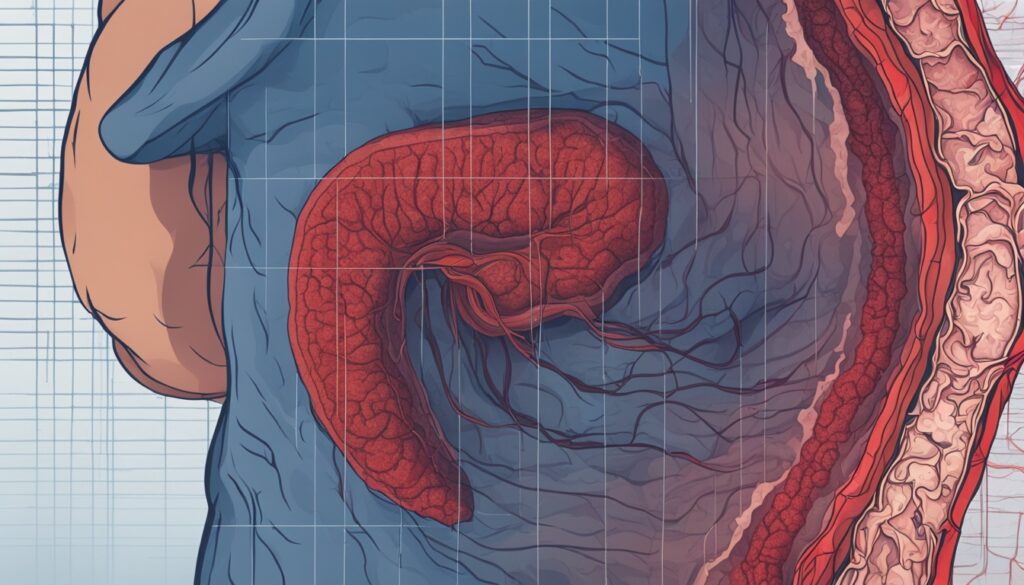Mesenteric ischemia is a serious condition. It happens when the arteries to your small intestine get narrow or blocked. This blocks blood flow. This can occur suddenly, called acute mesenteric ischemia, or slowly over time, known as chronic mesenteric ischemia. Early detection of symptoms and a quick diagnosis are critical. They are key to stop complications.
Table of Contents
ToggleAcute mesenteric ischemia shows up suddenly. You might feel intense stomach pain, have a strong urge to use the bathroom, and feel sick. The loss of blood flow is quick. In contrast, chronic mesenteric ischemia usually causes pain after meals. The pain gets worse for about an hour but then fades in 1-3 hours. People might avoid eating and lose weight without trying if this goes untreated.
Things like atrial fibrillation, congestive heart failure, and recent vascular surgery can increase your risk. So can having type 2 diabetes, high cholesterol, high blood pressure, smoking, and being obese. Knowing these risk factors helps doctors spot those who might get this condition. They can then watch those patients more closely.
Diagnosing mesenteric ischemia early is crucial. If left untreated, it can damage your bowel, cause sepsis, and lead to death. Tests like CT angiography can help confirm the diagnosis and find the best treatment. Understanding the symptoms and risks lets you seek help as soon as you notice any troubling signs. Doing this could save your life.
Understanding Mesenteric Ischemia
What is Mesenteric Ischemia?
Mesenteric ischemia happens when blood supply to the small intestine is cut off. It’s usually because the arteries get narrow or blocked. Without treatment, the small intestine can be badly hurt.
Types of Mesenteric Ischemia
There are two kinds: acute and chronic. A blood clot in the main mesenteric artery causes acute mesenteric ischemia. This clot often comes from the heart. Things like atrial fibrillation, heart failure, and recent surgeries raise the risk.
Chronic mesenteric ischemia, on the flip side, appears when arteries slowly narrow from fatty deposits. This narrowing or plaque build-up is behind it. Diabetes, high cholesterol, and other health issues can make you more likely to have chronic ischemia. Lifestyle factors like smoking, being overweight, and age also play a role.

Acute Mesenteric Ischemia Symptoms
Acute mesenteric ischemia causes sudden and intense abdominal pain. This pain doesn’t match what a doctor may find during a check-up. Patients also feel like they need the bathroom right away, and can have a fever and feel nauseous. These issues come fast because the small intestine loses its blood flow suddenly.
Sudden, Severe Abdominal Pain
The main sign of acute mesenteric ischemia is sharp, sudden stomach pain. This pain is very intense and not easy to point out where it hurts. It usually feels much worse than what a doctor sees during the exam.
Urgent Need for Bowel Movement
Feeling like they need to go to the bathroom is common for these patients. The body reacts to the lack of blood in the intestines by wanting to move any waste fast.
Fever and Nausea
As well as the severe stomach pain and sudden urge to use the bathroom, patients may get a fever and feel sick to their stomach. These signs show the body is trying to fight the damage caused by the lost blood flow.
It’s key to spot these symptoms quick and start treatment early. This is because acute mesenteric ischemia can harm the bowel, cause sepsis, and lead to death if left untreated.

Chronic Mesenteric Ischemia Symptoms
Chronic mesenteric ischemia comes on slowly. This happens when fatty deposits block the arteries to the small intestine. The main sign is stomach pain after eating, usually starting 30 minutes later. It gets worse and people may feel better after 1 to 3 hours. But, they might avoid eating because of the pain. This can lead to losing weight without trying. If not treated, this slow-progressing issue can turn into a medical emergency.
Abdominal Pain After Eating
Abdominal pain is a key sign of [chronic mesenteric ischemia]. It starts around 30 minutes after a meal. The pain worsens over an hour as the intestine doesn’t get enough blood.
Worsening Pain Over Time
The pain after eating may get worse with time. It might also last longer. This can make people avoid food. Eating less can cause them to lose weight without meaning to.
Pain Relief After a Few Hours
Oddly enough, the pain usually fades away 1-3 hours after a meal. This cycle of pain and then relief is a key clue to this Condition. It helps doctors tell it apart from other stomach issues.

Risk Factors for Mesenteric Ischemia
It’s key to know the risk factors for mesenteric ischemia for early detection and prevention. This condition, whether acute or chronic, has common risk factors. Knowing these can help lower someone’s risk.
Atrial Fibrillation and Heart Conditions
If someone has acute mesenteric ischemia, they might have atrial fibrillation or congestive heart failure. Recent vascular surgery also poses a risk. These issues can interrupt blood flow to the small intestine abruptly.
Vascular Surgery
Recent surgical procedures on arteries can raise the risk of acute mesenteric ischemia. For example, treating peripheral artery disease could lead to this problem. Some surgeries may accidentally affect blood flow to the intestines.
Diabetes, High Cholesterol, and Hypertension
Individuals with diabetes, high cholesterol, and hypertension are more prone to chronic mesenteric ischemia. Such health conditions aid in the gradual blockage of arteries with fatty deposits. This reduces blood flow to the gut with time.
Smoking and Obesity
Choices like smoking and being overweight can make chronic mesenteric ischemia more likely. They make vascular problems worse and decrease blood supply to the intestines.
Knowing these risks helps doctors find and look after high-risk patients. By tackling these factors with medical help and lifestyle changes, people can lower their mesenteric ischemia risk.
Recognizing Mesenteric Ischemia Symptoms
It’s vital to spot mesenteric ischemia symptoms early. This allows for quick treatment, which is key to avoiding serious issues. Signs of acute mesenteric ischemia include sudden and severe stomach pain, a strong urge to move bowels, fever, and feeling sick.
Differentiating Acute and Chronic Symptoms
Chronic mesenteric ischemia shows up more slowly. Pain in the stomach after meals gets worse but then lessens in 1-3 hours. Knowing these differences can guide healthcare providers in choosing the right tests and treatments. Keeping a sharp eye out, especially in those with risk factors, is critical for spotting and treating mesenteric ischemia early.

Complications of Untreated Mesenteric Ischemia
Untreated mesenteric ischemia can be very dangerous. It can cause severe, life-threatening issues. This shows why it’s important to get medical help fast.
Bowel Damage and Necrosis
Acute mesenteric ischemia stops blood from reaching the intestines. This can lead to the death of small intestine tissue. The damage can be quick and dangerous, possibly causing holes in the intestine or gangrene.
Sepsis and Organ Failure
When tissue in the intestines dies from ischemia, it can lead to sepsis. Sepsis is a severe response to infection. It can cause multiple organs to fail and spread inflammation throughout the body.
Malnutrition and Weight Loss
Chronic ischemia means less blood to the intestines over time. This can make patients not want to eat because of stomach pain. It can lead to malnutrition and severe weight loss, making the body weak and prone to more issues.
Knowing about the complications of mesenteric ischemia is crucial. Getting medical help soon is key to avoiding very serious effects. Early treatment and care are vital for a better recovery and to stop long-term problems.
Diagnostic Tests for Mesenteric Ischemia
Diagnosing mesenteric ischemia is tricky because the symptoms are not clear. But, several imaging tests can help find the condition. CT angiography is often the best choice. It shows detailed pictures of the mesenteric arteries and spots any blockages or narrowing.
CT Angiography
CT angiography is very good at diagnosing mesenteric ischemia. It uses a special dye in the blood. This helps doctors see clear, three-dimensional images of the mesenteric arteries. They can find areas where blood flow to the small intestine is blocked or narrowed.
Catheter Angiography
Diagnosing mesenteric ischemia can also be done through catheter angiography. This method puts a flexible tube called a catheter into the artery, usually the groin or arm. Contrast dye goes through the catheter, and X-rays show the mesenteric arteries. It offers more detailed insights, but it’s riskier due to its invasiveness.
Other Imaging Techniques
Though CT angiography and catheter angiography are top for diagnosing, other methods might help in some cases. This includes plain abdominal radiography, duplex ultrasonography, and magnetic resonance angiography (MRA). But, these are often used in addition to the more advanced tests.
Overall, doctors need both test results and clinical signs to diagnose and treat mesenteric ischemia accurately. Knowing the signs and getting medical help quickly is key to a good result.
Treatment Options for Mesenteric Ischemia
The main goal in treating mesenteric ischemia is to get blood flow back to the gut quickly. For acute cases, surgery is often needed. This can be to clear a blood clot, open a narrow artery, or create a new path for the blood. These surgeries aim to improve blood flow and stop more damage to the gut.
Surgical Interventions
When someone has acute mesenteric ischemia, fast surgery is key. Surgeons might need to remove a clot, make an artery bigger, or bypass the blockage. The main aim of these surgeries is to get blood flowing well again and check if the gut is still healthy. Quick treatment is vital; without it, the gut could suffer permanent damage.
Endovascular Procedures
In chronic cases, endovascular procedures could be an option instead of open surgery. Balloon angioplasty, a less invasive method, is used. It involves threading a catheter into the artery to widen it. Endovascular methods offer a good choice for those who can’t have major surgery.
Medication and Supportive Care
Supportive care plays a big part in treating mesenteric ischemia too. This includes giving fluids, using antibiotics to avoid infections, and managing health conditions like irregular heartbeats. Sometimes, drugs that help blood vessels relax or dissolve clots are used to boost blood flow and recovery.
Urgent treatment and a team of specialists are crucial for good results in mesenteric ischemia. Recognizing symptoms early, making a specific diagnosis, and starting treatment without delay all help. They reduce the chance of bad outcomes and make recovery more likely for those with the condition.
Preventing Mesenteric Ischemia
For patients at risk of mesenteric ischemia, it’s vital to take preventive steps. The key is to manage any conditions that up your risk. Also, start making healthy changes in your life.
Managing Underlying Conditions
If you have health issues like atrial fibrillation or diabetes, work closely with your doctor. Managing these concerns with medication and lifestyle changes is key. Doing so can greatly lower your risk of mesenteric ischemia.
Lifestyle Changes
Along with medical care, healthy life choices are crucial. Stop smoking and maintain a healthy weight. This means eating well and staying active. Avoid illegal drugs to keep your blood vessels healthy and reduce the risk of this disease.
Take a proactive stance to address your health conditions and risks. Early action and a focus on your well-being are your best defenses. With commitment, you can stop mesenteric ischemia and protect your health in the long run.
When to Seek Medical Attention
If you suddenly get a severe stomach ache that doesn’t go away, get help right away. It might mean you have acute mesenteric ischemia. This condition needs quick treatment to avoid serious issues.
Feeling pain in your stomach after eating, which gets worse but then fades within a few hours, needs a call to your doctor. This kind of pain pattern can point to chronic mesenteric ischemia. It also requires urgent medical care.
Do not wait or try to handle mesenteric ischemia alone. It can become life-threatening without treatment. Knowing the signs and getting the right help is key for a good outcome.
Prognosis and Recovery
How people do with mesenteric ischemia changes a lot. It depends on the kind and how bad it is. Also, how quickly doctors find it and start treating matters. Acute mesenteric ischemia is often severe, with death rates from 60% to 80%. But, fast surgery and care can really help these patients.
Chronic mesenteric ischemia can be better if treated early. But if not, it’s still serious. It can cause many problems, like sepsis or colon issues. This can lead to more health issues, like a heart attack.
How soon people get better from mesenteric ischemia just depends. Some can see quick changes after certain treatments. Others need surgery and more time to recover. Getting back to normal health can take a while for some.
Getting better and what happens next with mesenteric ischemia varies a lot. It’s about the patient’s health overall, the disease’s seriousness, and how well the treatment works. Quick action and care are key to doing better and avoiding serious problems.
When to Seek Medical Attention
If you have sudden, intense belly pain that won’t go away, seek emergency help right away. This kind of pain could show you have acute mesenteric ischemia. It needs fast treatment to stop severe problems. If your belly hurts more after meals but then eases in 1 to 3 hours, see your regular doctor. These signs might mean you have chronic mesenteric ischemia, which also needs quick medical care.
Don’t handle mesenteric ischemia alone. It can become life-threatening if you ignore it. Knowing the signs and getting the right care is key to a good recovery.
Knowing when to seek help for mesenteric ischemia is crucial. The fast and severe belly pain of acute ischemia means you need emergency care. This stops harm to your bowel and dangerous issues like sepsis. On the other hand, chronic ischemia causes slower belly pain after eating. But, it still demands quick medical attention to prevent it from getting worse or changing to the acute form.
Understanding the symptoms of mesenteric ischemia and getting the right medical care is vital. Whether your stomach pain is sudden and sharp or grows slowly after meals, noticing these signs and talking to a doctor swiftly can help effectively manage this severe illness.
Conclusion
Mesenteric ischemia is a dangerous health issue. It can be life-threatening. Early detection and treatment are key. Understanding the symptoms and risk factors helps with quick diagnosis.
Acute mesenteric ischemia shows up with intense stomach pain, sudden urge to use the bathroom, fever, and feeling sick. On the other hand, chronic mesenteric ischemia causes slow stomach pain that gets worse after meals but then gets better.
Recognizing these signs and getting help fast are crucial. Acute mesenteric ischemia can be deadly, with 60% to 80% mortality rates. It’s more common in older adults with serious health problems.
Learning about the causes and symptoms of mesenteric ischemia is important. It lets you be proactive about your health. Early treatment can prevent serious issues like bowel damage, sepsis, or even death.
So, don’t ignore any symptoms. If you’re worried, see a doctor. Take care of yourself and respond promptly to any health concerns.
FAQ
What is mesenteric ischemia?
Mesenteric ischemia happens when the arteries to the small intestine get blocked or narrowed. This stops enough blood from reaching the area.
What are the types of mesenteric ischemia?
There are two types. Acute mesenteric ischemia starts suddenly with severe belly pain. Chronic mesenteric ischemia comes on slowly from fats blocking arteries.
What are the symptoms of acute mesenteric ischemia?
The signs include strong, sudden belly pain, the need to move bowels fast, fever, and feeling sick.
What are the symptoms of chronic mesenteric ischemia?
In chronic cases, after you eat, your belly might start hurting. It gets worse for an hour or so, then goes away within 1 to 3 hours.
What are the risk factors for mesenteric ischemia?
Key risks involve heart issues, prior vascular surgery, and health problems like diabetes. Being overweight, smoking, and high cholesterol also increase risk.
How can I recognize the symptoms of mesenteric ischemia?
Knowing the sharp, sudden belly pain of acute mesenteric ischemia is vital. So is the slower belly pain of chronic mesenteric ischemia, especially after meals.
What are the complications of untreated mesenteric ischemia?
Unaddressed, it can cause severe bowel damage, blood poisoning, and malnutrition.
What diagnostic tests are used for mesenteric ischemia?
CT angiography is top for diagnosis. It takes detailed images of the mesenteric arteries, spotting any blockages or reductions in size.
What are the treatment options for mesenteric ischemia?
Quickly getting blood back to your intestine is the first aim. This might need surgery, procedures without cutting (endovascular), or just meds and care.
How can I prevent mesenteric ischemia?
Preventing it means managing heart and diabetes issues. Quit smoking, stay at a healthy weight, and exercise for life changes.
When should I seek medical attention for mesenteric ischemia?
Do this if sudden belly pain doesn’t stop or if belly pain after eating gets worse over time. It could be a sign of mesenteric ischemia.
What is the prognosis for mesenteric ischemia?
The outlook depends on condition type, its severity, and how fast it’s treated. Acute cases can be severe, but catching and managing chronic cases early improves the chances.
Source Links
- https://www.mayoclinic.org/diseases-conditions/mesenteric-ischemia/symptoms-causes/syc-20374989
- https://www.ncbi.nlm.nih.gov/books/NBK431068/
- https://www.hopkinsmedicine.org/health/conditions-and-diseases/mesenteric-ischemia
- https://my.clevelandclinic.org/health/diseases/23246-mesenteric-ischemia
- https://www.ncbi.nlm.nih.gov/books/NBK430748/
- https://www.ncbi.nlm.nih.gov/books/NBK513354/
- https://nyulangone.org/conditions/mesenteric-ischemia/diagnosis
- https://www.ncbi.nlm.nih.gov/pmc/articles/PMC4087969/


